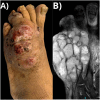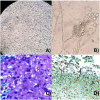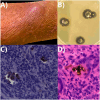Misleading subcutaneous mycosis: a case report of subsequent clinical mycetoma-like and histological chromoblastomycosis-like lesions
- PMID: 38865572
- PMCID: PMC11165563
- DOI: 10.1590/S1678-9946202466034
Misleading subcutaneous mycosis: a case report of subsequent clinical mycetoma-like and histological chromoblastomycosis-like lesions
Abstract
Hyalohyphomycosis and phaeohyphomycosis are groups of mycoses caused by several agents and show different clinical manifestations. We report a case of an immunocompromised patient who presented rare manifestations of opportunistic mycoses: mycetoma-like hyalohyphomycosis on his right foot caused by Colletotrichum gloeosporioides, followed by cutaneous phaeohyphomycosis on his right forearm caused by Exophiala oligosperma. Further to the rarity of this case, the patient's lesion on the foot shows that the clinical aspects of mycetomas could falsely appear in other fungal infections similar to hyalohyphomycosis. We also show that the muriform cells that were seen in the direct and anatomopathological examination of the skin are not pathognomonic of chromoblastomycosis, as observed in the lesion of the patient's forearm.
Conflict of interest statement
The authors declare they have no known financial competing interests or personal relationships.
Figures



Similar articles
-
Simultaneous distinct cutaneous fungal infections with chromoblastomycosis due to Exophiala xenobiotica and hyalohyphomycosis due to Scedosporium apiospermum in a patient with severe cellular immunodeficiency.J Dermatol. 2024 Dec;51(12):1716-1720. doi: 10.1111/1346-8138.17412. Epub 2024 Aug 5. J Dermatol. 2024. PMID: 39101398
-
Subcutaneous mycoses. Part 1: subcutaneous mycoses due to non-dermatophytes.G Ital Dermatol Venereol. 2013 Dec;148(6):621-31. G Ital Dermatol Venereol. 2013. PMID: 24442042 Review.
-
Subcutaneous mycoses: chromoblastomycosis, sporotrichosis and mycetoma.J Dtsch Dermatol Ges. 2010 Aug;8(8):619-27; quiz 628. doi: 10.1111/j.1610-0387.2010.07453.x. Epub 2010 Jun 7. J Dtsch Dermatol Ges. 2010. PMID: 20529168 English, German.
-
Chronic disfiguring facial lesions in an immunocompetent patient due to Exophiala spinifera: a case report and review of literature.Mycopathologia. 2012 Oct;174(4):293-9. doi: 10.1007/s11046-012-9548-5. Epub 2012 Jun 2. Mycopathologia. 2012. PMID: 22660887 Review.
-
Subcutaneous mycoses.Infect Dis Clin North Am. 2003 Mar;17(1):59-85, viii. doi: 10.1016/s0891-5520(02)00066-1. Infect Dis Clin North Am. 2003. PMID: 12751261 Review.
References
-
- Singh N, Chang FY, Gayowski T, Marino IR. Infections due to dematiaceous fungi in organ transplant recipients: case report and review. Clin Infect Dis. 1997;24:369–374. - PubMed
Publication types
MeSH terms
LinkOut - more resources
Full Text Sources

